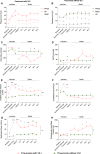A long-lasting porcine model of ARDS caused by pneumonia and ventilator-induced lung injury
- PMID: 37328874
- PMCID: PMC10276390
- DOI: 10.1186/s13054-023-04512-8
A long-lasting porcine model of ARDS caused by pneumonia and ventilator-induced lung injury
Abstract
Background: Animal models of acute respiratory distress syndrome (ARDS) do not completely resemble human ARDS, struggling translational research. We aimed to characterize a porcine model of ARDS induced by pneumonia-the most common risk factor in humans-and analyze the additional effect of ventilator-induced lung injury (VILI).
Methods: Bronchoscopy-guided instillation of a multidrug-resistant Pseudomonas aeruginosa strain was performed in ten healthy pigs. In six animals (pneumonia-with-VILI group), pulmonary damage was further increased by VILI applied 3 h before instillation and until ARDS was diagnosed by PaO2/FiO2 < 150 mmHg. Four animals (pneumonia-without-VILI group) were protectively ventilated 3 h before inoculum and thereafter. Gas exchange, respiratory mechanics, hemodynamics, microbiological studies and inflammatory markers were analyzed during the 96-h experiment. During necropsy, lobar samples were also analyzed.
Results: All animals from pneumonia-with-VILI group reached Berlin criteria for ARDS diagnosis until the end of experiment. The mean duration under ARDS diagnosis was 46.8 ± 7.7 h; the lowest PaO2/FiO2 was 83 ± 5.45 mmHg. The group of pigs that were not subjected to VILI did not meet ARDS criteria, even when presenting with bilateral pneumonia. Animals developing ARDS presented hemodynamic instability as well as severe hypercapnia despite high-minute ventilation. Unlike the pneumonia-without-VILI group, the ARDS animals presented lower static compliance (p = 0.011) and increased pulmonary permeability (p = 0.013). The highest burden of P. aeruginosa was found at pneumonia diagnosis in all animals, as well as a high inflammatory response shown by a release of interleukin (IL)-6 and IL-8. At histological examination, only animals comprising the pneumonia-with-VILI group presented signs consistent with diffuse alveolar damage.
Conclusions: In conclusion, we established an accurate pulmonary sepsis-induced ARDS model.
Keywords: ARDS; Double hit; Injurious mechanical ventilation; Pneumonia; Porcine model; Ventilator-induced lung injury.
© 2023. The Author(s).
Conflict of interest statement
The authors declare no competing interests.
Figures





References
-
- Ranieri VM, Rubenfeld GD, Thompson BT, Ferguson ND, Caldwell E, Fan E, Camporota L, Slutsky AS. Acute respiratory distress syndrome: the Berlin definition. JAMA. 2012;307(23):2526–2533. - PubMed
-
- Kolobow T, Moretti MP, Fumagalli R, Mascheroni D, Prato P, Chen V, Joris M. Severe impairment in lung function induced by high peak airway pressure during mechanical ventilation. An experimental study. Am Rev Respir Dis. 1987;135(2):312–315. - PubMed
-
- Protti A, Andreis DT, Monti M, Santini A, Sparacino CC, Langer T, Votta E, Gatti S, Lombardi L, Leopardi O, Masson S, Cressoni M, Gattinoni L. Lung stress and strain during mechanical ventilation: any difference between statics and dynamics? Crit Care Med. 2013;41(4):1046–1055. doi: 10.1097/CCM.0b013e31827417a6. - DOI - PubMed
-
- Cressoni M, Gotti M, Chiurazzi C, Massari D, Algieri I, Amini M, Cammaroto A, Brioni M, Montaruli C, Nikolla K, Guanziroli M, Dondossola D, Gatti S, Valerio V, Vergani GL, Pugni P, Cadringher P, Gagliano N, Gattinoni L. Mechanical power and development of ventilator-induced lung injury. Anesthesiology. 2016;124(5):1100–1108. doi: 10.1097/ALN.0000000000001056. - DOI - PubMed
Publication types
MeSH terms
LinkOut - more resources
Full Text Sources
Medical

